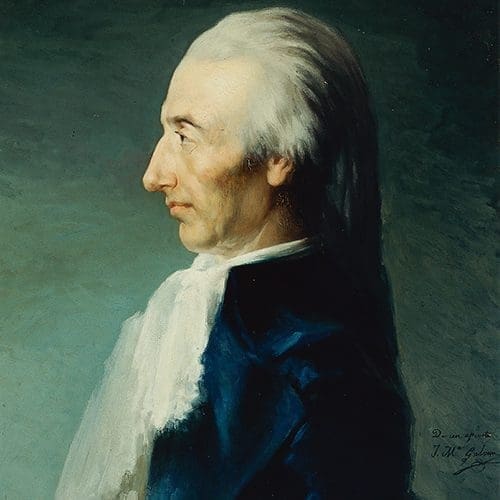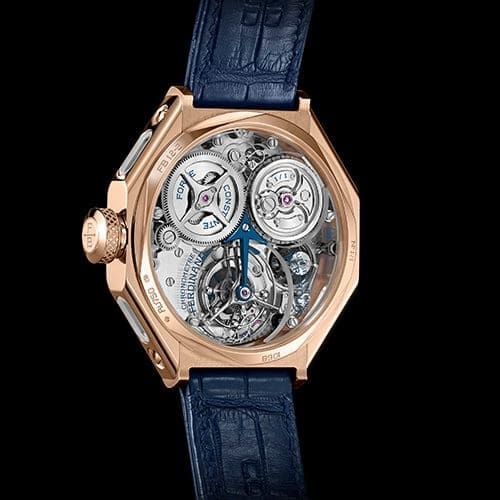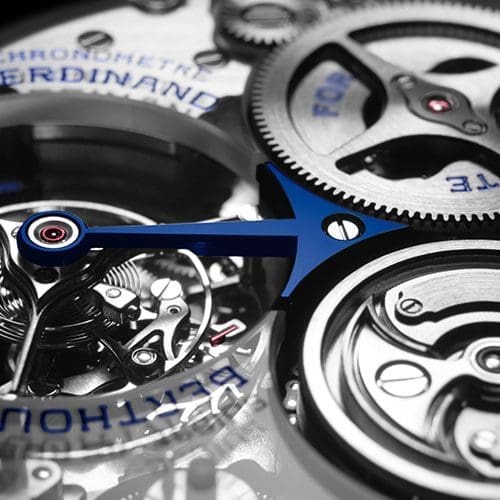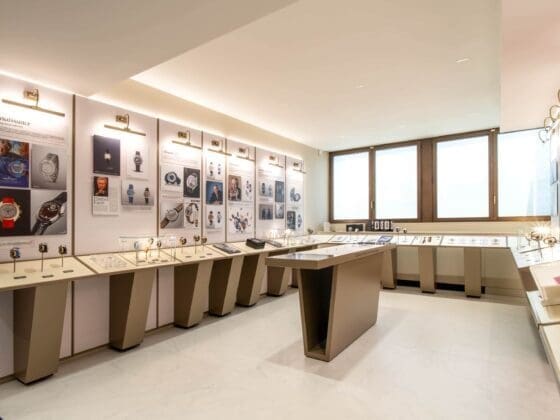Karl-Friedrich Scheufele, the Co-President of Chopard, has patiently assembled an impressive collection of objects relating to time measurement within the L.U.CEUM museum in Fleurier, including a significant number of works by Ferdinand Berthoud (1727-1807), the Master Watchmaker-Mechanic by appointment to the French King and Navy.
In 2015, Scheufele restructured the Ferdinand Berthoud name with an “innovative horological approach. From design to movement and finishing, everything composing these tourbillon and constant force chronometers is specific to them and reflects the uncompromising pursuit of excellence.”
This year, Ferdinand Berthoud commemorates the historic five-year voyage of Alessandro Malaspina to explore all Spanish territories in the Americas and South-East Asia with the aim of enhancing geological, botanical and zoological knowledge of these areas. This expedition was enabled by the presence of Ferdinand Berthoud’s Marine chronometers Nos. 10 and 13 being on board. The two were detached-escapement chronometers with a bimetallic grid, pillar-type structure and regulator-type dial.
Marine chronometers were the most advanced technological instruments of that time as they were the only devices capable of determining longitude at sea. Those made by Berthoud had the reputation of being the most accurate and reliable.
The Chronomètre FB 1 Malaspina’s 44 mm Octagonal case is identically shaped to the first three series of this chronometer but is crafted entirely in 18-carat rose gold for the first time. The flanks of the case have four lateral ‘portholes’ through which one can admire the movements within. An imposing knurled dynamometric crown in matching 18-carat rose gold ensures smooth winding of the movement. A glare-proofed sapphire crystal, domed and arched, covers the timepiece, as well as the fully transparent case-back. The watch has a water resistance of up to 30 metres.
The dial is a complex structure composed of three distinct elements. The main plate is made of vertical satin-brushed silver-toned brass. Then there is a hollowed 12-hours galvanic blue subdial with transferred white Arabic numerals that displays the hours and minutes. This offset construction was inspired by the marine chronometers that travelled with Malaspina on his exploratory voyage. Thirdly, there is a central dial opening, graced with finely hand-bevelled chamfers that reveals the wheels driving the mechanism within.
The only centrally placed hand is the seconds-hand which is exceptionally long, slender and made of gilded bronze. The seconds are displayed around the dial rim on a blued brass disc, enabling accurate reading of short times, the very essence of Ferdinand Berthoud timepieces.
The nature and provenance of the watch are set on this large dial, engraved with the inscription “Chronomètre Val-de-Travers Suisse” referring to the location of Ferdinand Berthoud workshops as a “proclamation of identity.”
The hand-wound Calibre FB-T.FC-2 movement is typical of 18th-century marine chronometers and is reflected in the design of all components, and in the symmetrical visual identity of the main movement sections. It features 15 nickel silver bridges and three sapphire half-bridges, held up by polished titanium pillars surrounding the mechanical organs.
The Calibre uses two mechanisms to ensure chronometric accuracy. First is the rare fusee-and-chain transmission, the oldest solution for supplying constant force to the escapement by countering the variance in the torque delivered by the barrel depending on its wind level. It gives a 53-hour power reserve.
The other source of the calibre’s accuracy stems from its tourbillon which is composed of 67 elements assembled within a 16.55 mm-diameter titanium carriage. It is fixed to an arrow-shaped steel arch. Another distinctive feature is the fact that it rotates at a rate of once-per-minute but does not display the seconds as it is also one of the rare tourbillons to have a central sweep-seconds hand.
The calibre’s three half-bridges are positioned on either side of the tourbillon, and between the barrel and the fusee and they are made of transparent sapphire in this model. Their contours have been entirely chamfered, “a supremely delicate and difficult operation given the hard and precious nature of this material.”
The blued steel arrow-shaped tourbillon bridge’s upper face is mirror-polished, the flanks are straight-grained, and the bevels are polished. All levels of the titanium tourbillon carriage are entirely chamfered, and the power-reserve cone is mirror-polished. The 285 mm-long chain composed of 790 steel components is entirely hand-finished. The edges and studs are satin-brushed, and the flat surfaces are polished.
All the finishing operations performed on the components of this watch, regarding their position and function, are hand-crafted by the artisans using traditional tools. The brand utilizes a “6x loupe” quality control process for these finishes whereby “no detail, however tiny, can go unnoticed. No errors, imperfections or inadequacies are tolerated.”
The one-of-a-kind Chronomètre FB 1 Malaspina Edition further exemplifies the Ferdinand Berthoud timepiece’s “respect for watchmaking tradition” and the brands “perpetual quest for excellence.”














